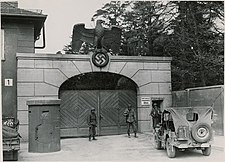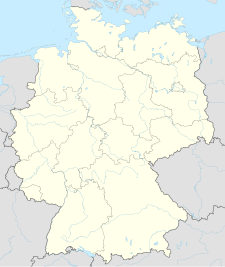Dachau Concentration Camp
| Dachau | |
|---|---|
| Concentration camp | |

American troops guarding the main entrance to Dachau just after liberation, 1945
|
|
|
Location of Dachau in Upper Bavaria
|
|
| Coordinates | 48°16′08″N 11°28′07″E / 48.26889°N 11.46861°ECoordinates: 48°16′08″N 11°28′07″E / 48.26889°N 11.46861°E |
| Location | Upper Bavaria, Southern Germany |
| Operated by | German Schutzstaffel (SS), U.S. Army (as internment camp after World War II) |
| Original use | Political prison |
| Operational | 1933–1945 |
| Inmates | Poles, Russians, Ukrainians, French, Yugoslavs, Czechs, Germans, Austrians, Hungarians, Italians, Jews, Homosexuals, Jehovah’s Witnesses, Communists, Gypsies |
| Number of inmates | over 188,000 (estimated) |
| Killed | 31,951 (reported) |
| Liberated by | United States, 29 April 1945 |
| Website | Dachau Concentration Camp Memorial Site |
Dachau concentration camp (German: Konzentrationslager (KZ) Dachau, IPA: [ˈdaxaʊ]) was the first of the Nazi concentration camps opened in Germany, intended to hold political prisoners. It is located on the grounds of an abandoned munitions factory northeast of the medieval town of Dachau, about 16 km (10 mi) northwest of Munich in the state of Bavaria, in southern Germany. Opened in 1933 by Heinrich Himmler, its purpose was enlarged to include forced labor, and eventually, the imprisonment of Jews, German and Austrian criminals, and eventually foreign nationals from countries that Germany occupied or invaded. The Dachau camp system grew to include nearly 100 sub-camps, which were mostly work camps or "Arbeitskommandos," and were located throughout southern Germany and Austria. The camps were liberated by U.S. forces on 29 April 1945.
Prisoners lived in constant fear of brutal treatment and terror detention including standing cells, floggings, the so-called tree or pole hanging, and standing at attention for extremely long periods. There were 32,000 documented deaths at the camp, and thousands that are undocumented.
Approximately 10,000 of the 30,000 prisoners were sick at the time of liberation.
In the postwar years the Dachau facility served to hold SS soldiers awaiting trial. After 1948, it held ethnic Germans who had been expelled from eastern Europe and were awaiting resettlement, and also was used for a time as a United States military base during the occupation. It was finally closed for use in 1960.
There are several religious memorials within the Memorial Site, which is open to the public.
After the takeover of Bavaria on 9 March 1933, Heinrich Himmler, then Chief of Police in Munich, began to speak with the administration of an unused gunpowder and munitions factory. He toured the site to see if it could be used for quartering protective-custody prisoners. The Concentration Camp at Dachau was opened 22 March 1933, with the arrival of about 200 prisoners from Stadelheim Prison in Munich and the Landsberg fortress (where Hitler had written Mein Kampf during his imprisonment). Himmler announced in the Münchner Neuesten Nachrichten newspaper that the camp could hold up to 5,000 people, and described it as "the first concentration camp for political prisoners" to be used to restore calm to Germany. It became the first regular concentration camp established by the coalition government of the National Socialist German Worker's Party (Nazi Party) and the German National People's Party (dissolved on 6 July 1933).
...
Wikipedia

